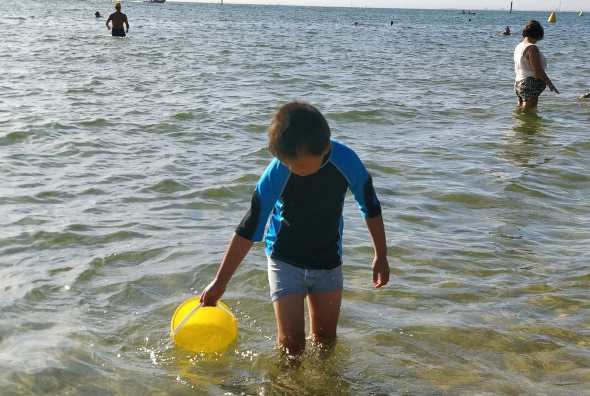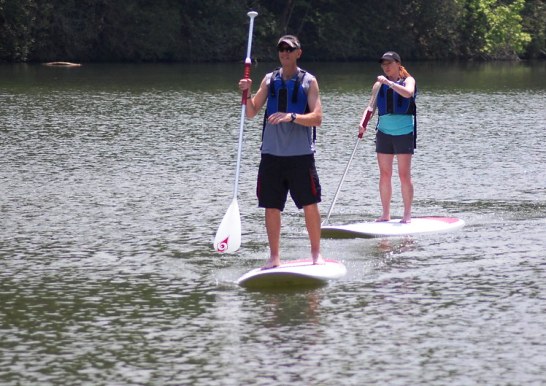Can You Paddle Board without Knowing How to Swim?
Is paddleboarding safe for non swimmers?
Well, if you live in a place that has a water body, the most logical thing to get into water sports is to start with knowing how to swim.
Sometimes, you could have missed the opportunity to learn how to swim when you were younger. Therefore, there might be no time to learn how to swim so that you can learn paddleboarding.
So, do you need to know how to swim to stand up paddle board? You can paddle board even without knowing how to swim, but we do not recommend that. If you must paddle when you don’t know how to swim, wear a PFD (personal flotation device) all the time. Coast Guard regulations require people under 13 years to wear PFDs while on a stand up paddle board.
Wear a PFD for paddleboarding if you can’t swim
Just in case you don’t have the time to read this article to the end, well, this is a one-off tip to help you have fun.
While adults are only required to have a PFD on their board when they are going out of the surfing zone, please wear one if you can’t swim, and you want to paddle board. If not, please enjoy paddleboarding in 30 to 35 inches of water.
Any PFD for paddleboarding is good, but if you can get one that will turn you over when you fall into the water, the better!
There … it is out! No swimming paddle boarding is a real thing. So will you jump right into the water right now and start stand up paddling?
Nope. Of course, you must have guessed that you cannot go out into the wild waters, or in the open ocean.
Therefore, if you do not know how to swim, there are some important considerations to bear in mind on how to prepare for paddleboarding.
Best water depth for paddling for non-swimmer

This is where everything begins. There are safe, and unsafe water depths for stand up paddleboarding when you can’t swim.
The water depth should neither be too shallow nor too deep. Here is a brief explanation:
60 to 70 inches of depth – not safe for you!
This kind of depth is not recommended for people who cannot swim. If you fall into the water in this depth, and you are not wearing a paddle board life jacket that can turn you over, you can drown easily.
This depth is safe for beginners who know how to swim, but even then, they should have the right board for the job. It is recommended to get a wider board, because it is more stable in the water.
If you are a beginner swimmer and SUP enthusiast, well, you might want to avoid paddling in such deep water.
Luckily, if you are paddleboarding in a lake, the water close to the shore is not too deep.
40 to 59 inches – again, not safe for a non-swimmer
In this kind of depth, the water is still not safe for non-swimmers. For most people of average height, this water level will get up to their eye level. So, as a non-swimmer, you are not safe at all.
Unless you really know how to maintain your balance on the paddle board, it is recommended that you don’t paddle in this kind of depth.
Even if you know how to maintain your balance, well, falling off the board into the water happens all the time, even to the best paddlers.
So, bottom line is … avoid taking your SUP board to water in this depth.
30 to 40 inches of water – Safe for non-swimmers
For most people, this kind of depth is just waist deep. Therefore, even if you fall into the water, you are not going to be in danger of drowning. This is a perfect depth for paddleboarding when you are not a swimmer.
In this water depth, the paddle board fins are safe, so they are not going to get snagged on the sand, but still, if there is seaweed, they could get snagged. So take a good note of the environment where you are paddleboarding.
10 to 29 inches of water – Safe, but too narrow
If the water is between 10 and 20 inches, do not paddle in it. At 10 inches, the fins will be sweeping the floor. This will damage your fins, and your board.
20 to 29 inches of water depth is okay for beginners, because the board’s fin will not get to the bottom, but if there are rocks, steer clear.
In this depth, please paddle while kneeling on the board, so that there is minimal risk even if you fall. However, if you paddle in such depth while standing, you can break your leg easily.
Safety tips for paddleboarding when you can’t swim

If you cannot swim, forget the advanced stand up paddle boarding techniques that you see on TV. You will have to start from the bare basics here.
And you will also need to wear a PFD, such as a type III life jacket on your person all the time! Here are helpful tips to help you get started on paddleboarding if you can’t swim.
1. Pick a safe place to paddle board
You will have to practice your stand up paddleboarding tips differently from people who can swim.
In this case, you will have to pick a water body that is calm, probably stagnant like a swimming pool and learn how to stand up paddle board there.
To do this, you will have to choose the best paddle board for swimming pool. This can be an inflatable or a solid paddle board.
If you learn how to paddle board in a pool, start on the shallow side. On the same note, you must wear your life jacket. Many people have drowned in swimming pools.
2. Know the depth – How much water can I SUP in if I don’t know how to swim?
You need just the right amount of water to paddle board in if you can’t swim.
For instance, 20 inches of water is very safe, but the fin of the SUP board is going to scrape the bottom. Therefore, you could damage your board.
Your best bet when it comes to the right depth of water to paddle board in is about 35 inches.
If it goes to 40 inches, you might find that you need the skills of a swimmer, especially if you fall off the paddle board and fall you will!
You can also choose to paddle board in a lagoon. Usually, the lagoon water does not exceed 3 feet at the deepest point.
Okay, it might go to your thigh, but we consider that safe because you will have your paddle board life jacket on.
At the same time, you will still have the leg leash attached, so you and the paddle board won’t drift too far apart.
The most important thing is to have a PFD on your person all the time. Whether you SUP board in a swimming pool or a lagoon, just ensure that you wear a PFD all the time.
3. Ask someone to keep an eye on you
When you are paddleboarding while you can’t swim, you should tell a friend or the instructors (mostly at a resort) to keep an eye on you.
Of course, even if you do fall from your stand up paddle board, you will still be attached to the board by the 4-foot leash.
Since the leash is tied to your leg, you can always pull the board towards you so that it can help you float.
All the same, make sure you have someone watching you, especially if the water is deeper than what we recommended.
4. Choose the best paddle board for a non-swimmer
To reiterate something that we have already mentioned, well, you need a board that is made for persons with no SUP skill whatsoever.
Without doubt, this is a large, inflatable, wide paddle board. You can look for the best Isle Surf boards. They have great options for beginner paddle boarders.
Rule of thumb … you should get a wide board, and by this, I mean the widest! It can be a solid board, but inflatables (iSUP) are more common.
Also, if this is your first ever SUP board to buy, make it cheap, since you will most likely abuse it, badly. This is not the time to get an expensive board like the Easy Eddy 3-Piece paddle board.
5. Carry your safety gear
If you cannot swim, you need to carry more safety gear than a person who can swim. For instance, wear a helmet. It will protect your head if you fall on a rock, piece of wood or something in the water.
Also, bring a whistle with you. That way, if you fall off the board and feel that the water is too deep, you can blow the whistle for attention.
Need we mention to paddle board if you can’t swim, you should stay near other people? In addition, you may wear a wetsuit if the water is cold.

6. Know your limits! Paddle Board When The Water Is Calm
If you can’t swim, and you need to paddle board, you should do it when the waters are calm, most likely in the morning.
If you know your limits, then you know that you want to stand-up paddle board in calm waters only.
Even when it is calm, the buoyancy of the water will still feel a tad too much for a person who doesn’t know how to swim. Therefore, you know that waves can cause your self-confidence to plummet badly.
How do you swim with a paddle board?
You might need to know how to swim with a paddle board if the leash breaks while you are in the water. Unfortunately, this does not apply to a person who is paddle boarding when they can’t swim.
The first thing to do when your SUP leash breaks is to secure that paddle shaft itself. Therefore, you need to hold it and swim with it.
Then you have to swim after the paddle board itself before it floats away with the current. Once you get the board, swim to the shore.
Next time, you should make sure that the paddle board is in proper condition, especially the leash so that it does not break.
Conclusion
Do you need to know how to swim to stand up paddle board? Well, we have said that it is not important. If you can learn how to swim first, do it.
If you just want to get started on paddle boarding if you can’t swim, you have seen the safety tips to bear in mind.
Remember, mind the water level, wear a PFD on your person all the time and have someone watching your back.

